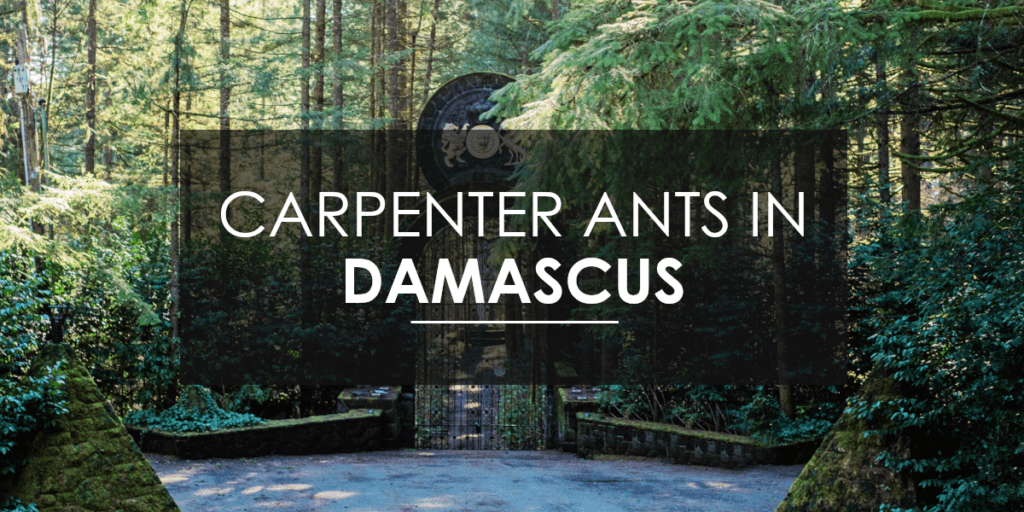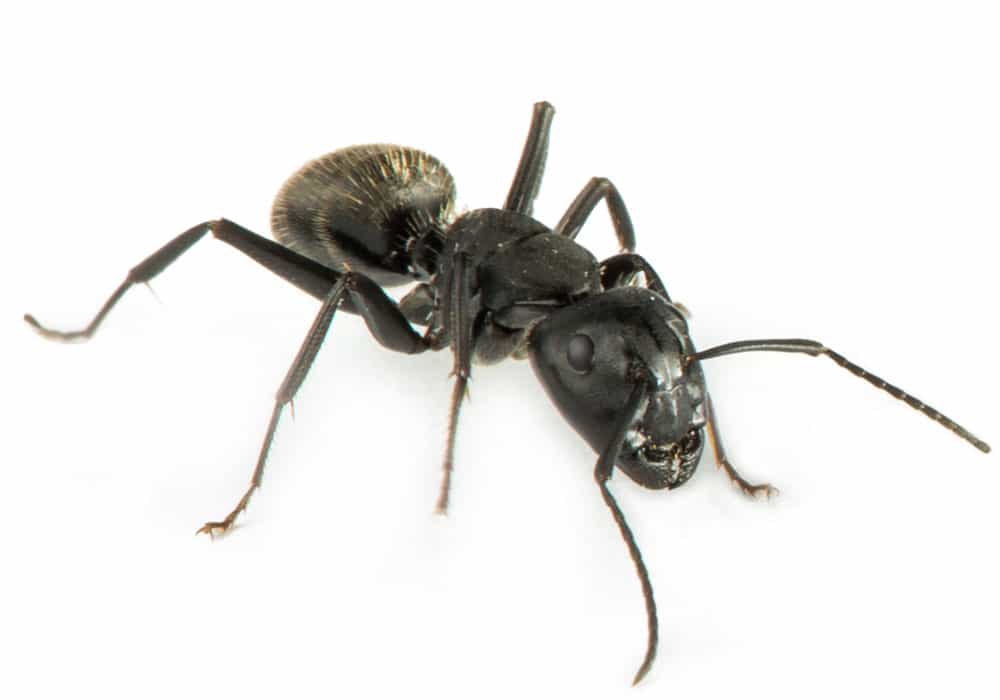Concerned about a carpenter ant infestation in or around your Vancouver, WA, home? We don’t blame you!
Aspen Pest Control is here to help you understand this pest, the risks they pose, offer recommendations for treatment, and provide guaranteed solutions to your carpenter ant problem.
What are carpenter ants?
Carpenter ants? Yikes! Those don’t sound good. And they’re not, but perhaps not precisely for the reason you think.
Carpenter ants, often incorrectly confused to be the same as termites, are large, black and red- or yellow-hued ants that burrow through wood (vs. consuming it, like termites) in order to build their nests and grow their colonies. With over 1,000 distinct species of carpenter ants that have been catalogued around the world, the carpenter ants we typically observe in North America are called the black carpenter ant.
Consisting of queens, workers, males, and larvae, these ants can measure as long as 14 millimeters in length (about 1 half-inch) and create complex systems of tunnels within their nesting sites. Workers are responsible for the building and maintaining of the nesting sites, and take their cues based on pheromones that come from the queens. Males of the colony live to mate, and will die shortly after mating takes place.
The colony will usually consist of small nests connected by tunnels that surround and all lead to the main nesting site. Queens are territorial and can become aggressive with one another if their boundaries aren’t respected. These nesting sites, in nature, are primarily found in dead trees and wood. However, the wood used to build homes and other residential and commercial structures is no less threatened by carpenter ants.
Carpenter ants do not eat wood as they cannot digest cellulose, and are predatory in nature, feeding on other insects like aphids, or by scavenging dead insects and extracting nutrition from the bodies in order to deliver it back to the colony.
If you suspect you have carpenter ants, we recommend taking a close look. Is the wood you’ve inspected splintered, or does it have very small holes in it? Are these splinters and small holes accompanied by what appears to be an almost powder-like sawdust? If so, there’s definitely a possibility that you’re facing a carpenter ant infestation and we recommend you contact professional pest management services as soon as possible in order to reduce further growth of the carpenter ant colony and further damage to your property.
Why do I have carpenter ants?
What kind of damage can they cause to my home?
Carpenter ants, like a lot of pests, are attracted to moisture. Naturally, living in Vancouver, WA — and the Pacific Northwest in general — means that carpenter ants are very active in this area for much of the year, and it’s important for home and property owners to pay special attention to those areas that are susceptible to water damage and rotting, both inside and outside the home. These areas are hot spots for carpenter ants, giving them an entry point that grows into damage that can extend all throughout the home.
Check for signs of activity in areas outside the home like eaves and other areas where water naturally drains, or those areas where drainage is not occuring due to clogged gutters and other similar maintenance issues. Inside the home, areas like bathrooms, kitchens, laundry rooms, utility rooms with sinks, and other places where moisture can collect and water damage can occur are also likely areas of carpenter ant activity.
If you see signs of carpenter ants in or around your home, then it’s most likely that the main colony is outside and that your home has become a satellite colony for the ants to further spread.
How can you be sure that what you’re experiencing is a carpenter ant infestation vs. a termite infestation? Well, before you’ve called upon professional help, we recommend you take a closer look. The pathways that carpenter ants and termites create in wood are also referred to as galleries. If there are visible galleries you can observe, what do they look like? Carpenter ant galleries are typically clean and smooth in nature, whereas termite galleries are commonly found to be full of sand and mud. Sawdust, debris, and even dead insects can be found outside of the entry points of carpenter ant colony sites.
In comparison, termites are known to cause a great deal of cosmetic and structural damage to wood — over $5 billion dollars in damage, annually, according to the National Pest Management Association — whereas the damage caused by carpenter ants is mostly cosmetic. However, if a carpenter ant infestation is left untreated, the damage caused accumulates over time and can result in serious structural damage.
The most important step you can take to protect your home is to call a team of professionals that will take the time to understand your concern, provide a thorough examination of your property and identify existing and potential problem areas. Ideally, you should choose a company that can offer hassle-free recommendations tailored to your unique situation, and will proceed accordingly with a treatment plan based upon your decision.
How do I get rid of a carpenter ant infestation?
We promise to never pressure our existing or potential clients into taking our recommendations. Our commitment to you is that we’ll always use our expertise as a way to offer guidance and value. Many folks wonder if they can treat carpenter ants on their own. Do they really need professional pest control services? Our answer is that while there are many DIY methods available, they usually only superficially treat your carpenter ant problem.
For instance, repellent sprays can be effective in treating and exterminating the carpenter ants you see, but are not effective in exterminating the heart of the colony nor the larvae contained therein. In order to confidently and effectively treat this type of infestation you need an expert with the right experience and expertise on your side.
When you call Aspen Pest Control, for carpenter ant extermination Vancouver WA residents trust, we’ll provide you with a hassle-free and free-of-charge consultation. In order to give you the best in pest control, we like to follow a simple but successful process where we Inspect the areas you’ve personally observed, as well as other potential problem areas the layperson might notice. Secondly, once you’ve fully understood the extent of your infestation and have agreed to treatment, we will Apply the appropriate volume of products at the appropriate recommended frequency. Most pest infestations require more than a single application of product. Lastly, Ongoing Observation of your infestation will help to ensure that we’ve not only rid your home of these pests, but that we’re also setting the stage to prevent future infestations from occurring.
In order to extend the effectiveness of treatment, 90% of Aspen Pest Control’s new customers choose our Home Protection Plan — an annual, four-times-per-year approach to pest control that our clients love because it deals with the pests that you have and prevents those you’re most likely to get from occurring. It’s a simple, predictable treatment plan that comes at a great value — and your satisfaction with our work is 100% guaranteed. If you’re a subscriber of Aspen Pest Control’s Home Protection Plan, then we’ll even come back in between regularly scheduled appointments if pests return, and we’ll keep coming back until they’re gone. Guaranteed.







